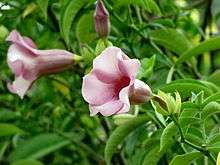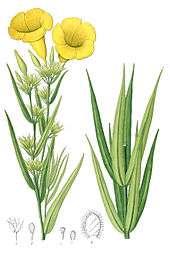Allamanda
Allamanda is a genus of flowering plants in the family Apocynaceae. They are native to the Americas, where they are distributed from Mexico to Argentina. Some species are familiar as ornamental plants cultivated for their large, colorful flowers. Most species produce yellow flowers; A. blanchetii bears pink.[2] The genus name Allamanda honors the Swiss botanist and physician Frédéric-Louis Allamand (1736–1809).[3] It also is official flower of Kuching North City Hall.[4]
| Allamanda | |
|---|---|
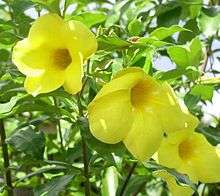 | |
| Allamanda cathartica | |
| Scientific classification | |
| Kingdom: | Plantae |
| Clade: | Tracheophytes |
| Clade: | Angiosperms |
| Clade: | Eudicots |
| Clade: | Asterids |
| Order: | Gentianales |
| Family: | Apocynaceae |
| Subfamily: | Rauvolfioideae |
| Tribe: | Plumerieae |
| Subtribe: | Allamandinae A.DC. in DC. & A.DC. |
| Genus: | Allamanda L. |
| Species | |
|
See text | |
| Synonyms[1] | |
| |
Description
Plants of the genus are evergreen trees,[3] shrubs, or vines. They contain a white latex. The leaves are opposite or arranged in whorls of up to 5. The blades are generally oval and smooth-edged, and some are leathery or lightly hairy. The inflorescence is a compound cyme. The flower has five lobed sepals and a bell- or funnel-shaped corolla of five petals, yellow in most species. The fruit is a schizocarp containing two to four seeds.[3]
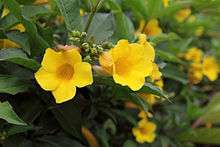

Chemistry and medicine
In lab analyses Allamanda species have yielded several chemical compounds, including iridoid lactones such as allamandin, plumericin, and plumierides. Plumericin particularly was demonstrated to be a highly potent NF-κB inhibitor with anti-inflammatory activity in vitro and in vivo, while its structurally related derivatives plumierdin, plumeridoid C, and allamandicin did not have activity.[5] The lignan pinoresinol and coumarins such as scopoletin and scoparone have been isolated from A. schottii.[6]
Allamanda species have been used in systems of traditional medicine for various purposes. A. cathartica has been used to treat liver tumors,[6] jaundice, splenomegaly, and malaria. In analyses, some species have shown some activity against carcinoma cells, pathogenic fungi, and HIV.
Cultivation
In the wild, allamandas grow along riverbanks and other open, sunny areas with adequate rainfall and perpetually moist substrate. The plants do not tolerate shade or salty or alkaline soils, and they are sensitive to frost. They grow rapidly, sometimes spreading 3 meters per year. They can be propagated from cuttings.
Can be trained as a standard.
Ecology
Allamandas have become naturalized throughout the tropics, growing in roadside ditches, abandoned yards, and dumps. A. cathartica in particular is an invasive species in Queensland.[7] Cutting is ineffective as a means of control, because the plants respond to coppicing.
Taxonomy
There are about 12 to 15 valid species in the genus.[3]
Species and synonyms include:
- Allamanda angustifolia Pohl
- Allamanda blanchetii A.DC. – purple allamanda, violet allamanda, violet trumpetvine
- Allamanda calcicola[2]
- Allamanda cathartica L. – yellow allamanda, golden-trumpet, common trumpetvine[8] brownbud allamanda[9]
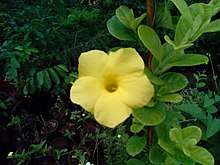 Allamanda flower found in Puducherry Union Territory of India
Allamanda flower found in Puducherry Union Territory of India - Allamanda doniana Müll.Arg.
- Allamanda laevis Markgr.
- Allamanda martii Müll.Arg.
- Allamanda nobilis T.Moore
- Allamanda oenotherifolia Pohl
- Allamanda polyantha Müll.Arg.
- Allamanda puberula A.DC.
- Allamanda schottii Pohl – bush allamanda[10]
- Allamanda setulosa Miq.
- Allamanda thevetifolia Müll.Arg.
- Allamanda weberbaueri Markgr.
| Wikimedia Commons has media related to Allamanda. |
References
- "World Checklist of Selected Plant Families". Retrieved May 22, 2014.
- de Souza-Silva, R. F. and A. Rapini. (2009). Allamanda calcicola (Apocynaceae), an overlooked new species from limestone outcrops in the States of Minas Gerais and Bahia, Brazil. Kew Bulletin 64(1), 171-74.
- Allamanda. FloraBase. Western Australian Herbarium.
- "Archived copy". Archived from the original on 2017-11-17. Retrieved 2017-11-16.CS1 maint: archived copy as title (link)
- Fakhrudin N, Waltenberger B, Cabaravdic M, Atanasov AG, Malainer C, Schachner D, Heiss EH, Liu R, Noha SM, Grzywacz AM, Mihaly-Bison J, Awad EM, Schuster D, Breuss JM, Rollinger JM, Bochkov V, Stuppner H, Dirsch VM. Identification of plumericin as a potent new scaffold inhibitor of the NF-κB pathway with anti-inflammatory activity in vitro and in vivo. Br J Pharmacol. 2013 Dec 16. doi:10.1111/bph.12558. PMID 24329519
- Schmidt, D. D. F. N., et al. (2006). Evaluation of the anti-proliferative effect the extracts of Allamanda blanchetti and A. schottii on the growth of leukemic and endothelial cells. J Pharm Pharm Sci 9, 200-08.
- Allamanda cathartica. Archived 2013-05-13 at the Wayback Machine Royal Botanic Gardens, Kew.
- "Allamanda cathartica". Germplasm Resources Information Network (GRIN). Agricultural Research Service (ARS), United States Department of Agriculture (USDA). Retrieved 29 December 2017.
- Allamanda cathartica. Atlas of Florida Vascular Plants. University of South Florida.
- "Allamanda schottii". Germplasm Resources Information Network (GRIN). Agricultural Research Service (ARS), United States Department of Agriculture (USDA). Retrieved 29 December 2017.
External links
- Allamanda cathartica. In: Francis, J. K. Wildland Shrubs of the United States and its Territories. USDA Forest Service, IITF, Shrub Sciences Laboratory.
- (in Portuguese) Allamanda. Flora Brasiliensis.
